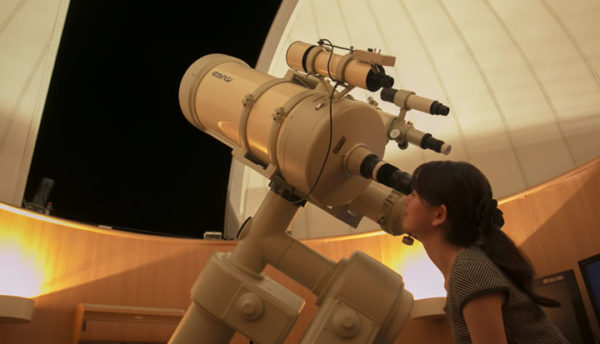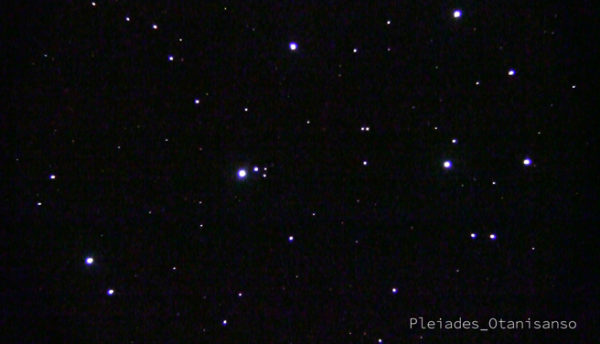- Astronomical Observatory
- 2019/10/06
【September in the Observatory】This month, come enjoy the harvest moon, and the last sight of Saturn and the binary star system Albireo with a view you can only get through a telescope!
This year, the Night of the Full Moon won’t actually have a full moon?! The truth about the Harvest Moon and how to enjoy it
 Hello, this is the Otani Sanso Astronomical Observatory Dome.Today we’ll be discussing what’s visible in Nagato Yumoto Onsen’s night skies in September, 2019. (Image: A photograph of the full moon taken through the telescope at Otani Sanso’s astronomical observatory dome in the past)
Hello, this is the Otani Sanso Astronomical Observatory Dome.Today we’ll be discussing what’s visible in Nagato Yumoto Onsen’s night skies in September, 2019. (Image: A photograph of the full moon taken through the telescope at Otani Sanso’s astronomical observatory dome in the past)
This year’s autumn harvest moon will be just shy of a full moon. The next day will be the smallest full moon of the year.
In September, the seasons shift from summer to fall. The skies, too, will begin to shift slowly from summer to fall, and then little by little into winter. We’d especially like you to take a look at the harvest moon on September 13th. This year’s harvest moon is actually just a day ahead of the full moon, and the full moon that we’ll see on September 14th will be the smallest of the year. With the full moon, in fact, its distance from the earth varies from a distance of about 356,000 km to about 406,000 km. When that distance is shorter the moon appears larger, and it appears smaller as the distance grows between them. The largest full moon (on February 20, 2019) had a diameter 14% larger than the smallest full moon, and it appeared about 30% brighter. There are many such changes that are indiscernable to the naked eye, but visitors to the astronomical observatory dome can come enjoy. One star that is difficult to make out with the naked eye is Albireo, a beautiful binary star system also known as the jewel of the heavens. Its beta star shimmers in the beak of the constellation Cygnus, which forms a portion of the Great Summer Triangle, and from our observatory, you can see its golden third-magnitude star and emerald green fith-magnitude stars shimmering closely together. This will also be the last month for viewing Jupiter and Saturn, which have shone brightly in the southern sky throughout the summer. In summer, we can enjoy sights of the planets, and in winter, the shimmering fixed stars in the night sky. Getting to enjoy the night sky particular to the year or season of your viewing is one of the delights of the astronomical observatory. Come escape the everyday with these shimmering lights that have traveled many tens of thousands of lightyears to reach us.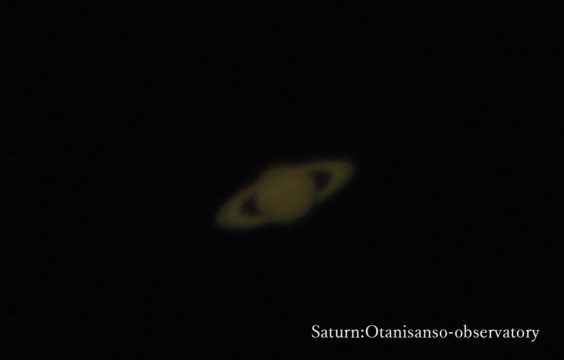
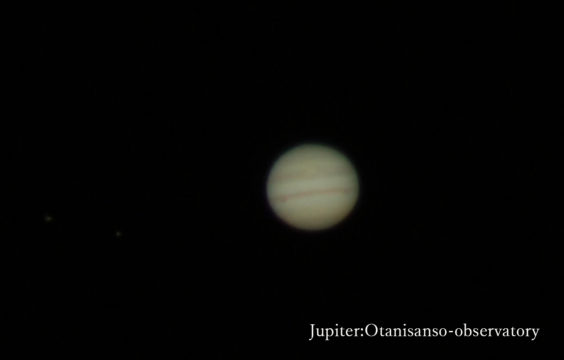
The “Night of the Full Moon” isn’t limited only to full moons!
The “harvest moon” actually refers to the moon on the 15th day of the 8th month in the old lunar calendar. In Japan, there is a tradition of using round votive offerings that imitate the beloved shape of the moon on this “Night of the Full Moon,” but is this moon truly a full moon? The “Night of the Full Moon” (in Japanese, literally, the “Fifteenth Night”), is, as its name suggests, the “fifteenth night since the New Moon,” but this day isn’t always a full moon. One cycle between New Moons usually lasts around 29.5 days, and from New Moon to Full Moon it takes an average of 14.8 days. Furthermore, because the earth’s orbit is elliptical, it’s actually more unusual for the moon to be full on the “Night of the Full Moon.” There is an explanation of the full moon on the National Astronomical Observatory of Japan Website now, so we’ve reproduced it below. The calendar wiki on the National Astronomical Observatory of Japan’s Celestial Calendar Calculation Department has a very good explanation.This year, August 30th (the New Moon will appear at 7:37 p.m.) is the first day of the eighth month in the lunisolar calendar, and September 13th is the 15th day of the eighth month in the lunisolar calendar. However, the astronomical meaning of a full moon is the moon at the moment the moon and the sun are exactly opposite one another, as seen from the earth. This time, the full moon will be on September 14th at 1:33 p.m. This year’s disparity between the date of the harvest moon and the date of the full moon happens frequently. To see more, please consult the National Astronomical Observatory of Japan’s Celestial Calendar Calculation Department’s Calendar Wiki page, “The harvest moon is not always a full moon” (Available only in Japanese). (Citation: Official Website of the National Astronomical Observatory of Japan, National Institutes of Natural Sciences)
Information about the stars in September
Expected Stellar Observations
- September 1 (Sun) – 3 (Tue): Jupiter, Saturn, Albireo
- September 4 (Wed) – 16 (Mon): Moon, Jupiter , Albireo
- September 17 (Tue) – 30 (Mon): Jupiter, Albireo
Star-Gazing Topics in September
- September 6 (Fri) …Waxing Moon, the Moon and Jupiter will draw very close to one another
- September 8 (Sun) …the Moon and Jupiter will draw very close to one another
- September 13 (Fri) …mid-Autumn Moon/Harvest Moon
- September 14 (Sat) …Full Moon
- September 22 (Sun) …Waning Moon
- September 23 (Mon) …Autumn Equinox
- September 29 (Sun) …New Moon
Please check the National Astronomical Observatory of Japan website for sunset times in Yamaguchi Prefecture. (See: National Astronomical Observatory of Japan Website) Available only in Japanese
Making a Reservation at the Astronomical Observatory
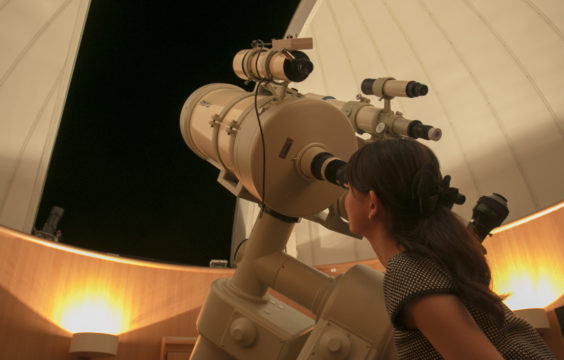
Details
- Observatory Hours… 7:30 p.m. – 10:10 p.m.
- Closed on… Every Tuesday
- Location… Otani Sanso Roof (Just beside the gallery on the 8th floor)
- Price… Free for overnight guests (Viewings available to those who reserve first)
- Using the Observatory… Viewings are available to those who reserve first (12 seats per viewing)
Observation Times
- 7:30 p.m., 7:50 p.m.
- 8:10 p.m., 8:30 p.m., 8:50 p.m.
- 9:10 p.m., 9:30 p.m., 9:50 p.m.
How to Make a Reservation
Please inform us of your desired reservation time from the times listed above (Please tell us via telephone, or write it in the “requests” field) *You may not be able to participate in a viewing if a time slot is fully booked, or due to weather conditions. *Should you be unable to participate in a viewing due to weather conditions, you will be able to see a video from a past viewing.See information from the astronomical observatory domeへ
■Frequently Asked Questions "Why is there an astronomical observatory on the roof of Otani Sanso?" The president of Otani Sanso, a great fan of the poems of Nagato/Senzaki-born Kaneko Misuzu, built the observatory out of a desire to "share the beautiful stars of Nagato with our guests, too." In fact, it was through a chance meeting via the Kaneko Misuzu Exchange Association that the president met with Dr. Haoru Saji, who greatly affected the president with the beauty of the stars he could see from the observatory at Tamagawa University even during the daytime. "There's much more than your eyes can see," Dr. Saji told him. "Let's take a look at the daytime stars." When you look up at the starry skies of Nagato, here, surrounded by nature, we hope you'll make memories to take home with you that you can look back on fondly.
Night Sky Trivia
The Speed of Light
- Light moves at a speed of approximately 300,000 km per second (7.5 revolutions around the Earth), and can cover 9.46 trillion km in a year.
- It takes light from the sun 8 minutes and 19 seconds to reach the earth.
- It takes 8 minutes and 19 seconds for light from the sun to reach the Earth.
Distances in Space
- Because space is so vast, we use “light years” and “astronomical units (AU)” to describe the distances between stars.
- 1 light year = the amount of distance light can travel in one year (9.5 trillion km)
- 1 astronomical unit = the distance between the sun and the Earth (approx. 150 million km)
Earth Time
- There are 24 hours in one day, but it takes 23 hours and 56 minutes for a rotation of the earth, leaving a margin of 4 minutes.
- The reason we have “leap years” is because the Earth’s orbital period around the sun is just shy of 365 Earth days.
- 1 rotation of the Earth (23 hours 56 minutes) = 400 m/sec
- 1 revolution of the Earth (365 days) = 30 km/sec
If you’d like to see more information about the night skies, the National Astronomical Observatory of Japan is extremely interesting. Please take a look.
